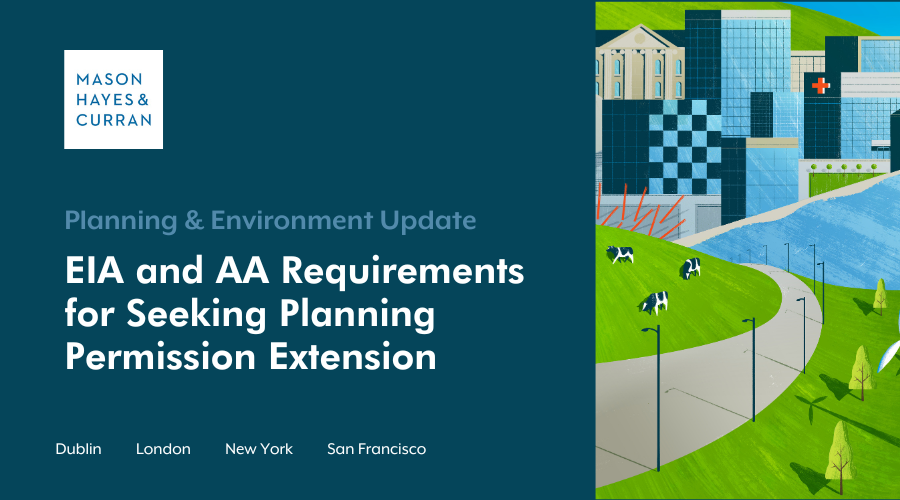
A recent High Court decision provides food for thought for applicants seeking an extension from a local authority to the appropriate period of planning permission. Deirdre Nagle, Head of Planning & Environment examines the impact of the court’s interpretation of the planning laws concerned.
The High Court has issued its decision on a developer’s challenge to a local authority’s rejection of its application to extend the appropriate period for planning permission. Ironborn Real Estate Limited (Developer), sought an extension of the appropriate period granted for its development works at Aiken’s Village, Stepaside, Dublin 18 under section 42 of the Planning and Development Act 2000 (the Act).
In rejecting the application, Dun Laoghaire Rathdown County Council (DLRCoCo) reasoned that section 42(8) of the Act precluded it from granting an extension where an environmental impact assessment (EIA) or appropriate assessment (AA) would be required for the entire development the subject of the planning permission. It was the developer’s contention that section 42(8) only precluded an extension where an EIA or AA would be required for the works remaining to be completed on foot of the planning permission sought to be extended.
DLRCoCo also relied on section 42(1)(a)(i)(IV) in rejecting the application, stating that in order to grant an extension, it needed to be satisfied that it was the developer’s intention to complete the development within a reasonable time.
In referring the matter to the High Court for judicial review, the developer sought to have the decision quashed on the basis that DLRCoCo had been incorrect in its interpretation of section 42 of the Act.
Having considered the rules of statutory interpretation and upon examination of the EU Directives from which the provisions originated, Judge Mulcahy agreed with the developer. He held that it was not permissible to interpret the relevant sections of the Act as imposing requirements which were not required by EU law He considered the Court bound to interpret section 42(8) in a manner that gave effect to EU law to the fullest extent possible. Put in other words, the Court was obliged to interpret the Irish legislation in accordance with the EU Directive:
“[I]n my view, the Council has erred in its interpretation of section 42(8). The assessment required for the purpose of that section is not required to be conducted by reference to the whole of the development the subject matter of the original grant of permission, but rather by reference only to the environmental effects of the development yet to take place which the decision to extend has the potential to authorise together with any additional environmental effects to which the change in completion date may give rise.”
On the second question, Judge Mulcahy found that it was reasonable for DLRCoCo to conclude that it was not satisfied that the development would be completed within a reasonable timeframe. In these circumstances, the rejection of the extension application was both legitimate and permissible and the developer’s challenge was dismissed.
Conclusion
Applicants for extension of the appropriate period will welcome the court’s findings on the extent of the development to be considered for the purposes of EIA and AA. It is clear from this judgment that it is only the works outstanding that must be considered when determining whether such an assessment is necessary.
The decision has also confirmed, a successful applicant must not only satisfy a local authority that the development is capable of being completed within a reasonable time but also that it is their intention to do so.
For more information, please contact a member of our Planning & Environment team.
The content of this article is provided for information purposes only and does not constitute legal or other advice.





